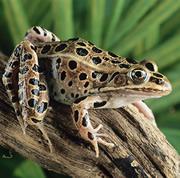 Pesticides that seem harmless on their own can have severe effects on frogs when in combination.© DAVID AUBREY / SCIENCE PHOTO LIBRARY
Pesticides that seem harmless on their own can have severe effects on frogs when in combination.© DAVID AUBREY / SCIENCE PHOTO LIBRARYPesticides used by US corn growers are combining to kill off the country's native frogs. Research shows that commonly used pesticides, fairly harmless by themselves, are mixing to create a toxic soup in runoff water. This stunts the frogs' sexual development and leaves them susceptible to fatal infections.
Environmental toxicologists led by Tyrone Hayes of the University of California, Berkeley, have spent the past four years surveying the effects of pest-control chemicals on frogs that live in the US corn belt in the Midwest.
“Global amphibian declines are the result of multiple assaults on their environment.”
Tyrone Hayes
University of California, Berkeley
The team raised northern leopard frogs (Rana pipiens) in water containing a combination of four weedkillers, two fungicides and three insecticides, and examined the effect on their growth.
"The nine-compound mixture represents that applied to the field at the time that eggs are laid in water that runs off the field," Hayes says.
Sum of all fears
The cumulative effect of the nine chemicals was greater than the sum of their individual properties, the researchers found.
When tested at concentrations of 0.1 parts per billion (ppb), six of the compounds had no effect at all, two had small but noticeable effects on development, and one - atrazine - caused serious developmental problems, but not death.
Yet all together, the combination killed 35% of frogs, and lengthened the time taken to develop from tadpole to adult by 15 days, or 25%.
The researchers suspect that the mixture stimulates production of stress hormones, which retard a frog's development. They publish their results on the website of the journal Environmental Health Perspectives1.
Small doses
Concentrations of 0.1 ppb are the lowest levels found in runoff water from cornfields during the summer, when frogs are growing and breeding. Concentrations can reach as much as 10 ppb, says Hayes.
For atrazine, concentrations of 0.1 ppb can be quite harmful, causing male African clawed frogs (Xenopus laevis) to grow 'feminine' gonads and show stunted growth of the larynx. Hayes has previously demonstrated this in both wild and lab frogs (see 'Atrazine gives frogs male and female gonads, says field study'); some of his new work shows that just a week of atrazine exposure is enough to cause the effect2.
But only the combination of all the pesticides seems to cause crippling developmental problems and death.
A delay in reaching adulthood may mean that ponds and puddles may dry out before frogs get the chance to reproduce, Hayes fears. And immune suppression may mean that they fall prey to otherwise benign infections.
Multiple assaults
Pesticides are just one of several reasons why amphibian populations are declining worldwide, Hayes says. "Global amphibian declines are the result of multiple assaults on their environment."
ADVERTISEMENT
Other potential threats to frogs and toads include increases in ultraviolet radiation from the Sun, climate change, draining of wetlands, and emerging diseases. Pesticide exposure may increase the damage done by these factors, Hayes suspects.
"Many 'emerging diseases' and deformities associated with infections may have bigger impacts in pesticide-exposed populations," he says. "Other researchers have shown similar effects, but not at concentrations as low as we used here."
A ban on atrazine was this year extended to encompass the entire European Union, but the chemical is still licensed in the United States. "I cannot predict whether it will be banned," says Hayes. "The industry is fighting hard to keep it on the market."
Post a comment to this story by visiting our cocktailkillsusfr.html">newsblog.
University of California, Berkeley
